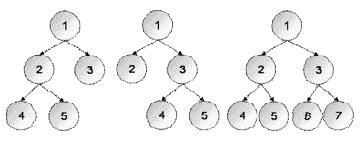Problem H
Another Counting Problem
Input: Standard Input
Output: Standard Output
Tree is an important data structure in Computer
Science. Of all trees we work with, Binary Tree is probably the most popular
one. A Binary Tree is called Strictly Binary Tree if every nonleaf
node in a binary tree has nonempty left and right subtrees. Let us define a
Strictly Binary Tree of depth d, as a Strictly Binary Tree that has at
least one root to leaf path of length d, and no root to leaf path in
that tree is longer than d. So let us use a similar reasoning to
define a generalized structure.
A n-ary Tree is called Strictly n-ary Tree if every nonleaf node in a n-ary tree has n children each. a Strictly n-ary Tree of depth d, then can be defined as a Strictly n-ary Tree that has at least one root to leaf path of length d, and no root to leaf path in that tree is longer than d.
Given the value of n and depth d, your task is to find the number of different strictly n-ary trees of depth d.
The figure below shows the 3 different strictly binary trees of depth 2.

Input
Input consists of several test cases. Each test case consists of two integers n (0 < n <= 32), d (0 <= d <= 16). Input is terminated a test case where n=0 and d=0, you must not process this test case.
Output
For each test case, print three integers, n, d and the number of different strictly n-ary trees of level d, in a single line. There will be a single space in between two integers of a line. You can assume that you would not be asked about cases where you had to consider trees that may have more than 210 nodes in a level of the tree. You may also find it useful to know that the answer for each test case will always fit in a 200 digit integer.
Sample
Input
Output for Sample Input
2 02 12 22 33 50 0 |
2 0 12 1 12 2 32 3 213 5 58871587162270592645034001 |
Problemsetter: Monirul Hasan